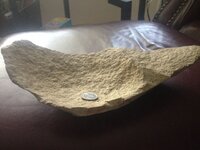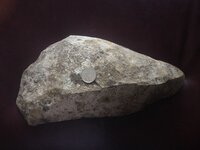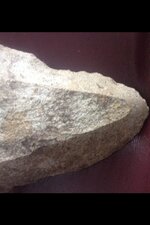Upvote
0
You are using an out of date browser. It may not display this or other websites correctly.
You should upgrade or use an alternative browser.
You should upgrade or use an alternative browser.
What?
- Thread starter D.E.A.P.
- Start date
The Grim Reaper
Gold Member
Everything fits perfect in the hand. That's the way hands are made to function.
Looks natural to me.
Looks natural to me.
- Thread starter
- #3
Could be. But the handle on closer examination sure looks to be worked. And it was found in a camp where I find a lot of artifacts. But like u said and I agree it could be natural. Thanks Grim. I do appreciate your input.
Steve
Steve
RGINN
Gold Member
- Oct 16, 2007
- 8,612
- 10,763
- 🏆 Honorable Mentions:
- 1
- Detector(s) used
- White's DFX, White's Classic 1 Coinmaster, Nokta Pointer
- Primary Interest:
- All Treasure Hunting
Spoons and ladles were mostly made from buffalo horn. And wood. I can't really see that used as any sort of bowl to cook in. My ancestors were more advanced in crafting tools than what some people give them credit for, and it wasn't all just Fred Flinstone stuff. It's just a rock on the site that has been broken maybe as a result of other activity there. Construction, road building, etc.?
unclemac
Gold Member
- Oct 12, 2011
- 7,022
- 6,917
- Primary Interest:
- Beach & Shallow Water Hunting
I agree with you but I also see a lot of "pestles" in river beds...why peck and grind something that you can pick up and modify slightly.
indian pestle | eBay
some of these "are" others "aren't"
I don't even pick these up anymore unless there is obvious modification...like a flat bottom or something like that.
indian pestle | eBay
some of these "are" others "aren't"
I don't even pick these up anymore unless there is obvious modification...like a flat bottom or something like that.
RGINN
Gold Member
- Oct 16, 2007
- 8,612
- 10,763
- 🏆 Honorable Mentions:
- 1
- Detector(s) used
- White's DFX, White's Classic 1 Coinmaster, Nokta Pointer
- Primary Interest:
- All Treasure Hunting
Oh definitely unclemac they would use things that were handy and at hand and could be adapted to use for the task without a whole lot of modification. Hard to spot those, and at least the rock D.E.A.P has was found in association with other known artifacts, but probably still just a rock. As heavy and cumbersome as they would have been before the horse, we have found granite grinding basins in SW Oklahoma up to a hundred miles from the source of that rock, so there is some evidence they carried these with them in their travels. They were highly prized and preferred over the local sandstone available. (If you ever get the chance to examine a prehistoric burial, note the grinding and wearing down of the teeth. This is a lot due to eating food that had been ground up on a sandstone basin.) A tip for everybody looking over old Indian campsites, turn over every larger flat rock you see. We found many instances where these were grinding basins turned upsided down to protect the grinding surface, as they intended to use these if they ever returned. Thinking of offbeat tips, if you have a village site that is presently in a plowed field, and it's been farmed for a long time, always walk the fence row. Those old farmers would toss big rocks there out of the field to keep from damaging the plow. One village site in northern Caddo County OK we observed a plethora of manos, metates, hammerstones, anvils, core stones, etc., that had been tossed out of the field back along the fence row. That one is an exceptional site with a long term prehistoric occupation of course, but pretty much every site we examine down there that's in a plowed field had an artifact or two that had been tossed over the fence line.
The Grim Reaper
Gold Member
Oh definitely unclemac they would use things that were handy and at hand and could be adapted to use for the task without a whole lot of modification. Hard to spot those, and at least the rock D.E.A.P has was found in association with other known artifacts, but probably still just a rock. As heavy and cumbersome as they would have been before the horse, we have found granite grinding basins in SW Oklahoma up to a hundred miles from the source of that rock, so there is some evidence they carried these with them in their travels. They were highly prized and preferred over the local sandstone available. (If you ever get the chance to examine a prehistoric burial, note the grinding and wearing down of the teeth. This is a lot due to eating food that had been ground up on a sandstone basin.) A tip for everybody looking over old Indian campsites, turn over every larger flat rock you see. We found many instances where these were grinding basins turned upsided down to protect the grinding surface, as they intended to use these if they ever returned. Thinking of offbeat tips, if you have a village site that is presently in a plowed field, and it's been farmed for a long time, always walk the fence row. Those old farmers would toss big rocks there out of the field to keep from damaging the plow. One village site in northern Caddo County OK we observed a plethora of manos, metates, hammerstones, anvils, core stones, etc., that had been tossed out of the field back along the fence row. That one is an exceptional site with a long term prehistoric occupation of course, but pretty much every site we examine down there that's in a plowed field had an artifact or two that had been tossed over the fence line.
Excellent advice. I too have found some nice pieces in farmers rock piles.
Top Member Reactions
-
 2393
2393 -
 1139
1139 -
 1101
1101 -
 896
896 -
 826
826 -
 803
803 -
 765
765 -
 738
738 -
 619
619 -
 506
506 -
 487
487 -
 473
473 -
 467
467 -
 426
426 -
 400
400 -
 394
394 -
O
368
-
 365
365 -
 362
362 -
 361
361
Users who are viewing this thread
Total: 2 (members: 0, guests: 2)







